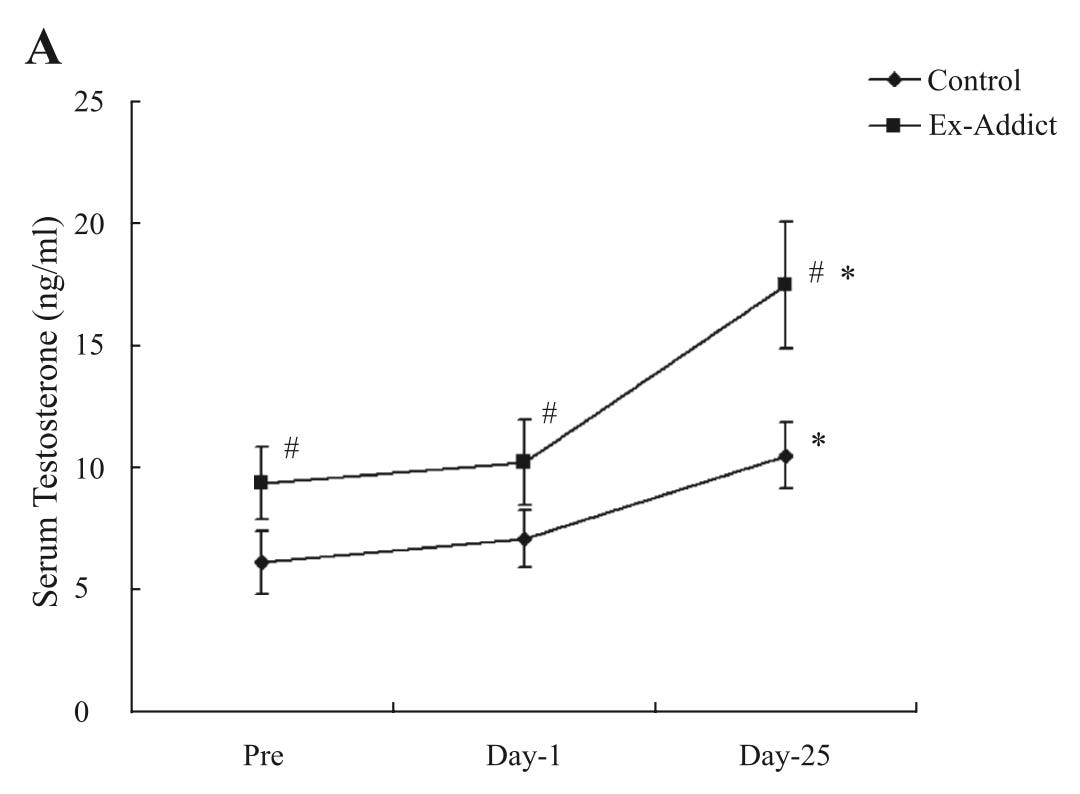In Five Ways to Increase Testosterone Naturally, I wrote about how properly dosed hypoxia training can increase testosterone up to 31%.
It appears from animal experiments that too much hypoxia can tank testosterone.
The most successful trial used simulation of 2000 meters (~6500 feet) 11-12 hours a day three days a week for four weeks. Testosterone went up by 31% and stayed elevated until the protocol was stopped.
Doing the protocol every day instead of three times a week led to a much lower rise in testosterone that did not reach statistical significance.
Another study simulated 2500 meters (~8200 feet) every day for 11 days. Testosterone increased at the 20-hour mark but this increase had started to return toward baseline by day 5 and lost significance by the end.
This indicates that 6500-8000 feet of altitude begins exceeding maximally valuable stimulus after about five straight days.
However, if we assume that the cumulative stimulus over time and the intervening recovery period is what matters, it may be that three sessions per week of 11-12 hours 6500 feet can be condensed into 5-6 days per month.
Thus, it may be that 5-6 days per month spent hiking, skiing, snowboarding, or doing whatever you want at the top of a mountain about 6500 feet above sea level is a great way to leverage a long-term rise in testosterone.
In nine recovering male drug addicts and 17 controls, 25 days spent in hiking Taiwan’s Central Mountain Ridge increased testosterone. Here the “controls” control from recovering drug addict status and not for the intervention. The recovering drug addicts improved their body composition but the controls did not. Both experienced a rise in testosterone, but the addicts more than the controls, possibly due to a positive effect of the exercise on body composition:
It is not clear what altitude the subjects were resting in, but they spent eight to nine hours a day hiking at 2200-3800 meters (~7200-12,500 feet). Resting time could have been anywhere from sea level to 1200 meters (4000 feet).
When over 100 subjects were transported by airplane from 500 meters (1640 feet) to 3700 meters (~12,000 feet), there testosterone went up after the first day but declined by day 7:
When ten healthy men were exposed to 11 days at 2040 meters (~6700 feet), their testosterone was increased by day seven but had started declining by day 9:
When ten healthy men were brought from Ann Arbor, Michigan to the top of Pike’s Peak, Colorado at 4300 meters (14,100 feet) for six days, their testosterone went up the whole time but it wasn’t statistically significant:
Still, it is 22% higher at the end.
When ten men had their salivary testosterone at different times of day compared to sea level (SL), one week of 3450 meters (11,000 feet) (SJ), six months of altitude (ALL), or to those of ten high-altitude natives (HAN), 7 days of altitude seemed to trash noon-time testosterone, while six months seemed to create a high-testosterone rebound, and the high-altitude natives seemed to have intermediate testosterone. Salivary testosterone is thought to reflect the free testosterone and is therefore thought to be influenced by sex hormone-binding globulin, and not just total testosterone output.
When high-altitude-living men and low-altitude-living men in Peru had their urinary testosterone compared, it started out at a similar level, but the sea level subjects had much greater response to injections of hCG.
In Finnish cross-country skiers and biathalonists, spending 8-15 days at 1650 meters (~5400 feet) increased resting testosterone by 19%.
The most robust inference is that intermittent altitude increases testosterone, but there comes a point where too much altitude causes a loss of the benefit.
Testosterone is probably highest when intermittent altitude exposure is matched with sufficient recovery time at lower altitude.
The magnitude of the altitude stress probably makes a big difference:
For 1650 meters/5400 feet, 8-15 days in a row produces a net benefit.
For 2040 meters/6700 feet, 7 days in a row appears to be the maximal tolerable stress.
For 3700 meters/12,000 feet, one day produces benefit and there is net loss by seven days.
The Taiwan hiking expedition showed benefit extending to 25 days, but the altitude exposure was gradually increased over 8-9 hours a day of hiking and the altitude at rest was unclear. Further, the best benefit is in the recovering drug addicts where part of the benefit came from improved body composition.
The controlled studies cited at the beginning imply that the robust 31% increase in testosterone experienced with ~33-36 hours per week of 2000 meters/6500 feet can be carried on indefinitely, while 2500 meters/8200 feet every single day starts losing benefit after five consecutive days.
The long-term adaptations as shown in saliva and urine probably reflect free testosterone and adaptations involving sex-hormone binding globulin. My guess is testosterone production is compromised at long-term high altitude, and declines in sex-hormone binding globulin step in to mitigate this.
Therefore, the most evidence-based protocol is to spend three 11- to 12-hour events at 2000 meters/6500 feet per week.
But the most plausible adaptation that would potentially be dramatically more fun and rewarding is to spend 5-6 days per month spent hiking, skiing, snowboarding, or doing whatever you want at the top of a mountain at 5,000-8,000 feet above sea level.










This validates my spending more time in the mountains with my camper van! Thanks so much for this article!
Great excuse to take a vacation!